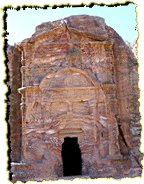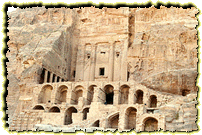 |
 |
 |
|
|||
|
Exploring the Ruins of Petra
Finally, we're in Jordan. The first thing I notice is the music -- it's everywhere -- in our van, during meals, even lurching through a scenic day long desert tour in World War II jeeps. Muhammed, our guide to Petra, seems impervious to the desert. Without sunglasses, hat, or water bottle, he can walk and talk longer than any of us. If we were inattentive, or talked over him, he had a phrase, EXCUSE ME PLEASE! "Excuse me please!" becomes the trip mantra. As we approach Petra, the desert foothills gradually become high cliffs and slick rock that resembles Utah sandstone. My expectations rise as we walk into the "Siq," a narrow path between the red and golden, eroded rock cliffs, which tower 600 feet above us. This narrow path is partly why the ancient nabateans built Petra here...a small force could defend the hidden fortress city against a much larger army...much of Nabatean history is still guesswork, but we do know their kingdom rose in the 6th century BCE and they flourished by controlling Middle Eastern trade routes stretching over a thousand miles from Damascus Syria to southern Saudi Arabia. In return for protection from bandits and access to water, the Nabateans imposed heavy tolls on merchants trading silk, ivory, spices and animal hides. Even today, nomadic Bedouins still make their living from travelers by selling transportation.
Even the lovely song in the background translates to "How about a donkey?"
"Excuse me please, please. Now we are passing the Treasury." Rumor has it that the "protection tax" paid by trade caravans didn't always work. After the downfall of the Nabatean Kingdom, bandits robbed merchants and hid their looted gold here earning it the name Treasury. Muhammed explained that one Nabatean King used some buildings as guesthouses for friends, and a later, less hospitable king buried defeated enemies here. Most tourists stay and explore the lower tombs in the flat sandy area in front of the Treasury. But there are many buildings and tombs above the cliffs and only the more hardy souls venture up! Petra is a huge complex of buildings as we can see from the 890 stone steps up to the Monastery. We're accompanied by a Bedouin who's herding his goats along the same path. Like all Petra ruins, the Monastery is carved directly into the rock. We walk inside and discover the back of the building is the mountain itself.
The Monastery was carved more than three centuries before Christ was born. Yet, archaeologists have found crosses within, indicating that later the structure was a Christian church. As we start to walk down, I wonder how many more centuries and transformations Petra will see. In Petra, Jordan, this is Joan Reinhardt Reiss for the Savvy Traveler.
|
 | American Public Media Home | Search | How to Listen ©2004 American Public Media | Terms of Use | Privacy Policy |

 We bump our way across the brown semi-desert in a new van. The Red Sea
stretches out to the south and dead ahead the resort city of Aquaba
shimmers in the sun. We're
dropped at a white wooden single story building without air
conditioning. There are about 100 other tourists milling around.
Crossing from Israel to Jordan is a high security experience.
We bump our way across the brown semi-desert in a new van. The Red Sea
stretches out to the south and dead ahead the resort city of Aquaba
shimmers in the sun. We're
dropped at a white wooden single story building without air
conditioning. There are about 100 other tourists milling around.
Crossing from Israel to Jordan is a high security experience.
 The Siq narrows even further until suddenly through the large
opening between the irregular rock cliffs the sun illuminates our
first look at the Treasury -- Petra's most famous building.. The exquisite
golden
temple, high above us has unbelievable Greek columns and statues
carved directly out of the rock. The building served as both temple and tomb -
one of the many Petra tombs. The statues are a bit worn and headless but the
temple is in remarkable shape for something built about 2,000 years ago. You
may have even seen it in the final scenes of Indiana Jones and the Last
Crusade.
The Siq narrows even further until suddenly through the large
opening between the irregular rock cliffs the sun illuminates our
first look at the Treasury -- Petra's most famous building.. The exquisite
golden
temple, high above us has unbelievable Greek columns and statues
carved directly out of the rock. The building served as both temple and tomb -
one of the many Petra tombs. The statues are a bit worn and headless but the
temple is in remarkable shape for something built about 2,000 years ago. You
may have even seen it in the final scenes of Indiana Jones and the Last
Crusade.